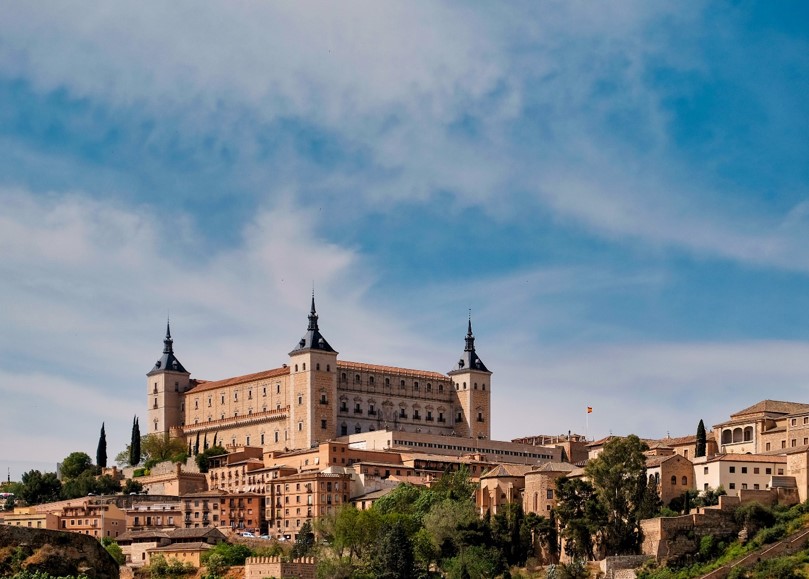
Dark tourism means visiting places that haven’t seen a good past. Although Spain is not known for its dark tourism, it has surely seen some worst days in the past. Whether during WWII or the Spanish Civil War, Spain has a lot of dark tourist attractions.
Here we have listed top 5 locations for dark tourism in Spain that deserve your visit:
Near the city of Zaragoza, a destroyed town, Belchite exists, which was demolished in 1937 during the Spanish Civil War. That battle is remembered as a battle of Belchite.
In the Battle of Belchite, military operations and offenses were performed by the leadership of the Republican Military on and around the town of Belchite, only to slow down the Nationalists’ advancement. Military equipment and thousands of troops destroyed the whole town.
Then ordered by Francisco Franco, the demolished town was left untouched as a monument to give a glimpse of the severity and destruction that was caused by the Spanish Civil War.
From the artillery positions in the caves and holes of Lobo Hill from where the Republican Military fired at the town Belchite, to the impacts it made on the town, everything is preserved and is a great attraction for dark tourism. Visitors from all over the world travel to Spain to see the destroyed yet breathtaking town of Belchite. You would think after all these years and so much war that around the world, we would find peace, but alas, I don’t think humankind will ever find that balance. Sorry, y’all-it’s dark!
Alcazar can’t go unnoticed by your eyes – it dominates above and in the middle of Toledo city, and its past gives it a well-deserved attraction for dark tourism in Spain.
The Alcazar de Toledo was the location of the blockade of Alcazar. Even after the aggressive attempts by the Republican military, José Moscardó Ituarte – the Nationalist Colonel, maintained to hold the fort. The legend says that the Colonel retained his control even when his son was kidnapped and ultimately shot. The bullet holes on the walls still reflect the intensity of that war.
This site is a symbol of Spanish nationalism because of the blockade of Alcazar. The damage that was done is still preserved, and thousands of people from around the world visit this fort to have a glimpse of the war. I’m always amazed by how beautiful something can be and yet have so much darkness affiliated with its past.
Located in Huerta de San Vicenta, Granada – is the home of Federico García Lorca. Federico Garcia Lorca – one of the most famous Spanish writers of the 20th century – was a poet, prose writer, and playwright, and what does he have in common with dark tourism? Well, he was shot. Dark enough for ya?
Lorca was committed to the Second Republic and the progression of its political, social, and cultural projects from 1931 to 1936. In February 1936, he openly sympathized with the elected Front Government. Also, he was always open about his homosexuality.
All these factors contributed to his detention. Later on, he was assassinated by the military rebels’ supporters on 19th August 1936 – at the beginning of the Spanish Civil War. Lorca was living in his home at the time he was killed. Because of this, his house was dedicated to his life, writings, and activism.
Casa Museo Federico García Lorca is a great public attraction for tourism, and its past attracts people looking for dark tourism in Spain.
A controversial monument, the Valley of the Fallen near Madrid is both awe-inspiring and somber. Built under the orders of Francisco Franco, it serves as a resting place for those who died during the Spanish Civil War. The colossal cross, a towering 500 feet (152 meters) high, dominates the landscape and can be seen from miles away.The monument’s construction involved the labor of political prisoners, adding a dark layer to its history.
Today, the Valley of the Fallen remains a contentious symbol, and its eerie atmosphere draws dark tourists who seek to explore its crypts and ponder the complex legacy of Franco’s regime.
The Valley of the Fallen was intended as a memorial to those who died during the Spanish Civil War. However, it has been a controversial site due to its association with Franco’s regime and the forced labor used in its construction. Many of the workers involved in building the monument were political prisoners, and conditions were harsh.
The most prominent feature of the Valley of the Fallen is the colossal cross, which is one of the largest in the world, standing at over 150 meters (500 feet) tall. The basilica carved into the mountainside contains a crypt where Franco’s remains were interred upon his death. The monument was initially presented as a symbol of reconciliation, but it has become a source of contention, and discussions surrounding its future use and significance have continued in Spain.
Visitors to the Valley of the Fallen can explore the basilica, the crypt, and the surrounding area. The site raises questions about how to memorialize complex historical events and figures, particularly when they are tied to authoritarian regimes and human rights abuses.
Overlooking the city of Barcelona, Montjuïc Castle has witnessed centuries of history, including periods of military conflict and political repression. it is the best location for Dark Tourism in Spain. During the Spanish Civil War, it served as a prison and execution site for those who opposed the Franco regime.
Visitors can explore its dark past while enjoying panoramic views of Barcelona and reflecting on the political turmoil that unfolded within its walls. It served as a prison and execution site for both sides of the conflict. The Republican government couldn’t resist flexing their power and executed a whole bunch of political prisoners there – anarchists, communists, and anti-fascists, oh my! This place became a symbol of repression and political violence during that dark period of time.
But hold on tight, because the world has a funny way of turning tragedy into something “interesting.” Enter dark tourism, the not-so-subtle fascination with visiting sites associated with death, suffering, and tragedy. And guess what? Montjuïc Castle falls smack dab into that category. People can’t resist the morbid allure of digging deep into historical events and paying tribute to those who suffered.
Montjuïc Castle hasn’t completely forgotten its twisted past. It’s held on to some aspects of its history, including exhibits related to the Spanish Civil War. But here’s the plot twist: it’s not all about dwelling on the darkness. Nope, it’s evolved and has undergone some fancy renovations and transformations. The site now aims to present a comprehensive historical narrative that goes beyond its dark past.
So, my daring friends, if you’re up for a riveting and thought-provoking adventure, Montjuïc Castle might just be the ticket. It’s all about gaining a deeper understanding of historical events and paying your respects to those who went through hell in those walls. But remember, it’s not all doom and gloom – there’s a comprehensive history awaiting your exploration.
While it may not have a violent past like some other Dark Tourism in Spain, the Hospital de Sant Pau in Barcelona holds a unique place in history. It was designed by architect Lluís Domènech I Montaner and is a masterpiece of Modernisme architecture. During the Spanish Civil War, it served as a makeshift hospital for wounded soldiers.
Today, the hospital has been transformed into a museum, offering insights into its role during the war and its architectural significance.
While Spain is known for its tapas and flamenco dancers and not necessarily for Dark Tourism in Spain, there’s plenty of history and sites to go around. I’ve highlighted three good ones that will make you stand in awe as it opens your eyes to the dark past that each hold. Why not take a break from sipping on your Spanish wines, or heck, take them with you on your way to visit the past? And while you’re there, always remember to Travel Till You Drop!
Use Skyscanner to find a cheap flight. This is my very first stop when I’m looking for my next trip. It’s a fast, easy-to-use search engine that is perfect for finding an affordable flight, a perfect hotel, and the right rental car for you in locations around the globe.
If you are looking for a super budget friendly location and are open to a hostel stay, make sure you book your hostel with Hostelworld. It offers the broadest range of quality hostels around the world.
If you’d prefer a hotel or a guesthouse for stays less than 28 days, drop on over to Booking.com It’s perfect for providing excellent options, a ton of user reviews, and prices to fit every budget.
For stays over 28 days, AirBnB still remains my #1 choice. User reviews and monthly pricing allow for some incredible deals all around the world.
Travel insurance is but a small up-front investment that you won’t want to leave home without. After just one experience of having to delay or cancel your trip or having your luggage stolen, you’ll wish you would have made that investment. I’ve hated my life a few times when the moment arose, and I decided to skip out. Let’s just say, I’ve changed my ways and recommend each of the following companies to protect your ass-ets.
Travel credit cards allow you to earn points that can be redeemed for free flights and accommodation — all without any extra spending. Check out my guide to getting free flights to get started.
Check out my Resource Page for the best companies to help you book your travel at reduced rates! This list will help you get to where you’re going. I know-I use them ALL the time!


Hi, Jill Here
Hi! I’m Jill, a Dallas, Texas girl traveling the world. After a career in the Air Force and touring over 50 countries later, my need to explore keeps going! It’s time to rock & roll and find all those places I never knew I was missing.
Table of Contents
Join me to get exclusive travel tips, giveaways and more!
Gallery
Copyright © 2023 | All Right Reserved